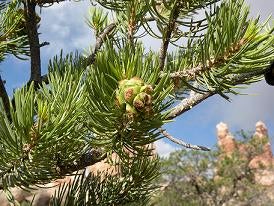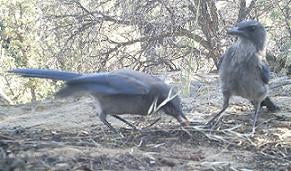
La página que intenta visitar sólo está disponible en inglés. ¡Disculpa!
The page you are about to visit is currently only available in English. Sorry!

 A new study finds that man-made noise has ripple effects on plants such as pinyon pine, whose natural seed dispersers tend to avoid noisy areas. (Photo courtesy of Clinton Francis) |
Despite its powerful 30-foot stance, the pinyon pine is paralyzed, relying heavily on birds and other mammals to help it reproduce. When its seeds drop from cones, birds, along with other creatures, collect and bury them. Though most seeds are eaten, those left behind take root and eventually sprout. This system has helped the pinyon pine populate a wide range in the American west, but an invisible threat could affect the dispersal and future of the tree and other plants: sound.
A growing body of research has shown that even the invisible waves of manmade noise alter animal behavior. In the last few decades, scientists found that low-frequency pitched larger birds are less likely to settle in cities among the din of traffic and that some songbirds will sing louder and longer in noisy surroundings. A new study suggests that the effects of such manmade noise on birds and other animals impacts plants that rely on those species for seed dispersal and pollination.
“We were really interested in trying to understand how noise, as it alters the behavior of some animals, could trigger other consequences for species that depend on species with unique response to noise,” says Clinton Francis, the study’s lead author and scholar at the National Evolutionary Synthesis Center in Durham, North Carolina. The study appears in the March 21 issue of Proceedings of the Royal Society B. Other authors of the study include Catherine Ortega, most recently of Fort Lewis College, and Alexander Cruz and Nathan Kleist of the University of Colorado, Boulder.
 Western scrub jays collect pinyon seeds. Researchers found that western scrub jays avoid noisy areas and are less likely to collect and disperse pinyon pine seeds around manmade noise. (Photo courtesy of Clinton Francis) |
Between 2007 and 2010, Francis and his colleagues conducted a series of experiments in the Bureau of Land Management’s Canyon Wildlife Area in New Mexico, where thousands of natural gas wells—and their noisy compressors—are located. To see if noise from the gas wells might impact pinyon pines in the area, researchers scattered the plant’s seeds in both noisy and quiet sites. A motion triggered camera allowed researchers to see which animals took the seeds.
Several animals fed on both sites equally during a three-day period, but researchers found that in particular mice preferred noisy sites while western scrub jays avoided them completely. Because seeds eaten by mice won’t survive digestion, the noisy areas that mice prefer are likely to have less pinyon pines in the future, the study says. On the other hand, pinyon pine seeds collected by the jays in quiet areas can eventually sprout, Francis explains.
“There is a lot of evidence that the western scrub jay and the pinyon pine co-evolved,” he says. “A single scrub jay in the fall, when a lot of these seeds are available, will collect and disperse hundreds, covering them under a few centimeters of soil. While they end up recovering lots of seeds, it’s many of those forgotten sees that end of becoming the future of the forest.”
Researchers also counted the number of pinyon pine seedlings in quiet and noisy areas. They found that seedlings were four times as abundant in quiet sites compared to noisy ones.
The study shows that manmade noise not only affects animal behavior, but may impact the future of pinyon pines.
“Effects of noise might be found decades after the noise is removed,” Francis says, explaining that it takes decades for a pinyon pine to grow into a full-sized tree, and less seedlings means less trees in the future.
In another experiment using artificial colored pollen and fake flowers, researchers found pollen transfer was more common in noisy sites. The study also showed that black-chinned hummingbird made five times more visits to noisy sites than quiet ones. Unlike the pinyon pine, the study suggests that hummingbird-pollinated plants would indirectly benefit from noise.
Francis explains that the study shows the advantages to looking at environmental issues with a community ecological perspective.
“We’re getting beyond the idea that noise has singular impacts,” he says. “Our study shows that noise needs more attention—perhaps on par with other issues like habitat fragmentation or disturbance.”
Related:
Study Suggests City Songbirds Shift Pitch for Skyscrapers